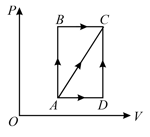First Law of Thermodynamics
First Law of Thermodynamics: Overview
This topic covers concepts such as Sign Convention in Thermodynamics, First Law of Thermodynamics, First Law of Thermodynamics in Isochoric Process, Heat in Isochoric Process, First Law of Thermodynamics in Isobaric Process, etc.
Important Questions on First Law of Thermodynamics
An ideal gas is allowed to expand freely against vacuum in a rigid insulated container. The gas undergoes
When heat is supplied to the system then is ____ and is ____ when heat is extracted from the system. Choose the appropriate option.
The ratio of work done by an ideal monoatomic gas to the heat supplied to it in an isobaric process is
When a system is taken from state to state along the path , it is found that and . Along the path , and along the path is
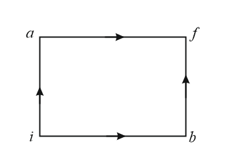
The diagram of a system undergoing thermodynamic transformation is shown in figure. The work done by the system in going from is and heat is given to the system. The change in internal energy between and is

Two moles of a monatomic ideal gas are taken through a cyclic process shown on the diagram. The process is represented as = constant. If the efficiency of the given cyclic process is , then what is the value of ?
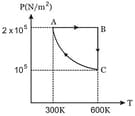
of rigid diatomic gas performs a work of when heat is supplied to it. The molar heat capacity of the gas during this transformation is The value of is ________ .
A monatomic ideal gas undergoes a process . The heat given to the gas is,
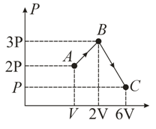
An ideal gas undergoes change in its state from the initial state to the final state via two possible paths as shown below. Then,
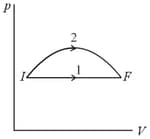
One mole of an ideal monatomic gas is taken through a semicircular thermodynamic process shown in the diagram. The heat supplied to the system is
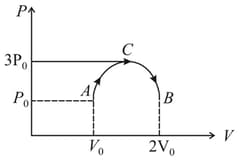
The workdone on the system in changing the state of a gas adiabatically from equilibrium state to equilibrium state is . If the gas is taken from state to through another process in which the net heat absorbed by the system is , then the net workdone by the system in the later case is
An electric heater supplies heat to a system at a rate of If the system performs Work at a rate of joules per second, the rate at which internal energy changes is
Two cylinders and of equal capacity are connected to each other via a stopcock. A contains an ideal gas at standard temperature and pressure. is empty. Then the entire system is thermally insulated. The stopcock is suddenly opened. After the gas reaches equilibrium the temperature of the gas measured. Which of the following is correct?
of water at , is completely converted to steam at , occupies . The increase in the internal energy of the molecules is:
(take the pressure , Latent heat of vaporisation )
A graph of pressure against volume of an ideal gas undergoing an isothermal process is ____
As shown in the figure, the amount of heat absorbed along the path is and the amount of work done by the system is . If the amount of work done along the path is the amount of heat absorbed will be:
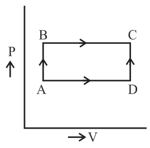
When a system is taken from state to state along the path , it is found that and . Along the path , . Work (in ) along the path is-

In thermodynamic process pressure of a fixed mass of gas is changed in such a manner that the gas releases joule of heat and joule of work was done on the gas. If the initial internal energy of the gas was joule, then, the final internal energy (in J) will be:
One mole of a perfect gas in a cylinder fitted with a piston has a pressure , volume and temperature . If the temperature is increased by keeping pressure constant, the increase in volume is :-
A thermodynamic process is shown in the figure. The pressures and volumes corresponding to some points in the figure are: and . In process of heat is added to the system and in process of heat is added to the system. The change in internal energy(in ) of the system in the process would be,
